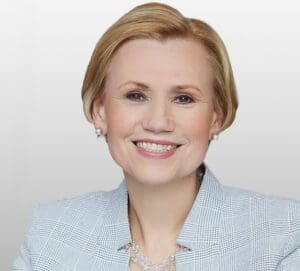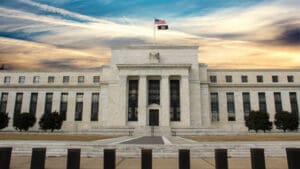Key takeaways
Federal Reserve
The Fed held rates steady in June but projected two more rate hikes before the end of the year.
European Central Bank
The ECB hiked rates and made it clear that there’s more work to be done in the inflation fight.
Japan and China
Japan maintained its accommodative policy, while China lowered rates to help boost its economy.
Last week was a big one for monetary policy, with four major central banks rendering policy decisions. Their decisions reflect the fact that their respective economies are in very different places.
The Federal Reserve holds steady for now
The week started with the US Federal Reserve (Fed) holding rates at current levels. But it was a decidedly hawkish pause, with the Fed suggesting more rate hikes could be coming soon. The Summary of Economic Projections — known as the “dot plot” – showed that the Fed anticipates two more rate hikes this year. This is borne of concerns that core inflation is too sticky – the Fed revised up its projection for core inflation and revised down its projection for unemployment for the end of the year. Now the dot plot is just each member’s policy prescription — it can be very wrong at times, and it can change significantly over time. You may recall that the dot plot released in December 2021 forecast a median fed funds rate of 0.90% by the end of 2022.1 The Fed couldn’t have been more wrong, as the fed funds rate ended 2022 in the 4.25%–4.50% range.1
And so markets seemed to shrug off this development, even though Fed Chair Jay Powell shared during his press conference that “nearly all” committee members expected further rate tightening in 2023 would be necessary to bring down inflation. My read on this hawkish dot plot and Powell’s hawkish words is that they’re intended to stop the market from assuming there will be any rate cuts this year and keep financial conditions from easing. The Fed wants to keep inflation falling — and prevent any reacceleration.
The Fed is faced with a resilient US economy, one that seems to be handling the aggressive tightening cycle very well. The labor market remains surprisingly tight, which could mean that inflation remains stubbornly high. And so the Fed is comfortable with a hawkish pause and the ability to hold further tightening — that “sword of Damocles” — over markets.
Having said that, if the Fed does tighten two more times this year, I believe it really risks overkill — sending the economy into a significant recession. I’m sounding like a broken record, but I’ll say it again: There is a lengthy lag between when monetary policy is implemented and when it actually shows up in the real economy data, which Powell acknowledged in the press conference. We haven’t seen much of an impact yet because of that lag. That’s why we have to worry so much about overkill. I believe today’s Federal Open Market Committee (FOMC) should heed the words of then-San Francisco Fed President Janet Yellen, who shared the following thoughts during the May 2006 FOMC meeting2:
“I strongly favor a pause in our campaign in order to evaluate the effect of our policy actions to date, unless incoming data after this meeting contain large upside surprises….I do certainly understand the urge to continue raising rates at every meeting until we’re sure the economy is slowing. I still remember very well the 1994 tightening episode, and then, as now, there was a sense of great momentum in the economy, posing significant upside risks to inflation. In circumstances like that, the urge to continue tightening is natural. It is instinctual. Unfortunately, with policy lags such a strategy is a sure recipe for overshooting. If we’re lucky enough to stop at exactly the right point this time, as I believe we actually did in ‘95, we can be sure that it will feel risky at the moment we stop and wise only in retrospect. The risks for policy, in my view, are now two-sided…”
The European Central Bank continues to hike
The European Central Bank (ECB) hiked rates last week with more to come, which I believe is appropriate. The eurozone economy is in a different place than the US economy. The ECB started hiking rates later and has not been as aggressive. In particular, the ECB stuck with the transitory inflation philosophy even longer than the Fed or Bank of England.
It turned out demand was very strong on reopening in the eurozone. Plus, European governments, such as the UK, in effect supported both household and business spending by insulating their economies from the energy price shock with price controls and budgetary subsidies. The result was that eurozone (and UK) consumption and business spending have been stronger than expected, and inflation has been higher than expected. Hence it is no surprise that ECB President Christine Lagarde made it clear that there is more work to be done.
The Bank of Japan stays patient
The Bank of Japan (BOJ) maintained its ultra-accommodative monetary policy at its meeting last week and said it would continue to “patiently” maintain this policy. This surprised some given that Japan has experienced higher-than-expected inflation in the past year and that the BOJ upwardly revised its expectations for employment and household income.
Japan is an outlier among major developed economies. It’s experiencing its strongest economic growth in decades, and the BOJ may not want to prematurely extinguish it. Not surprisingly, the Japanese yen fell in response. I suspect the BOJ will need to implement some tweaks to its yield curve control policy in coming months or quarters, but it seems willing to keep its key policy rate lower for longer, tolerating the risks of elevated inflation since it is something of a welcome curiosity for an economy that has been in the doldrums for multiple decades.
The People’s Bank of China seeks to enable economic growth
Then there is the People’s Bank of China, which actually increased monetary policy accommodation while much of the world is tightening. This makes sense. I believe the economic recovery has long legs. But I also recognize that disappointment with recent economic data has triggered a growing view that China may not have provided enough stimulus during the pandemic relative to other major economies and that its economy could benefit from more stimulus now. The People’s Bank of China is lowering policy rates to help goose the nascent economic recovery.
Up next: The Bank of England
Another major monetary policy decision — from the Bank of England (BOE) — is coming this week. The BOE is between a rock and a hard place as the UK experiences a weak economy plagued by high inflation — though it has to be said that UK growth has proven more resilient than most everyone expected (including the BOE itself).
I expect the BOE to hike rates even though that would hurt UK households who are already suffering from higher mortgage rates. With Prime Minister Rishi Sunak’s government saying it will not provide fiscal help to these households, the BOE — similar to the Bank of Canada, which hiked rates earlier this month — risks hurting the economy more than it helps in its attempts to combat inflation.
Having said that, the BOE probably has the strongest case of any of the major developed market central banks to tighten more aggressively and for longer than had been expected. Inflation is high, and the UK needs the BOE to get a grip on it. This is likely better for gilts and sterling than for UK equities in the shorter term, as UK consumers may well feel the pinch on both real incomes and mortgage payments from high inflation and interest rates.
Investors react to these developments
Taking a step back, the general mood among US investors is becoming more positive. There is a realization that the US is at or very close to the end of its tightening cycle, and the economy has remained resilient – especially the labor market.
US high yield credit spreads have narrowed in recent months, suggesting a greater likelihood of a softer landing for the US economy, which should be positive for the global economy. And, reflecting a growing sense of investment FOMO — the fear of missing out — the most recent American Association of Individual Investors survey shows the widest bullish-bearish spread since November 2021.3 Monetary policy matters, and it’s generally becoming more supportive of risk assets.
Other investors are not as positive. For example, the Eurozone Sentix Investor Confidence reading has been pessimistic for some time, clocking lower in the last two weeks.4 A contributing factor is likely the ECB’s hawkish monetary policy stance. In addition, a lot of negative sentiment is likely priced into Chinese equities already, and they are trading at the low end of their historical valuation range, despite more monetary and fiscal stimulus in the offing.
Negative sentiment presents opportunities. There should be a growing realization that it is not just the US — that other major Western developed central banks are at or nearing the end of their tightening cycles while the Bank of Japan and the People’s Bank of China are maintaining or increasing their accommodative monetary policies. I believe this is a time to be looking for attractively valued assets with upside potential for the next year and beyond.
With contributions from Arnab Das and David Chao
Footnotes
- 1Source: US Federal Reserve
- 2Source: FOMC minutes, May 10, 2006
- 3Source: American Association of Individual Investors, June 15, 2023. The AAII’s Investor Sentiment Survey shows the percentage of investors who are bullish, bearish, or neutral on stocks.
- 4Source: Sentix, GmbH, June 5, 2023
—
Originally Posted June 21, 2023
Global central bank decisions reflect distinct differences in their economies by Invesco US
Important information
NA2962955
Past performance is not a guarantee of future results.
This does not constitute a recommendation of any investment strategy or product for a particular investor. Investors should consult a financial professional before making any investment decisions.
All investing involves risk, including the risk of loss.
An investment cannot be made directly in an index.
In general, stock values fluctuate, sometimes widely, in response to activities specific to the company as well as general market, economic and political conditions.
The Federal Reserve’s “dot plot” is a chart that the central bank uses to illustrate its outlook for the path of interest rates.
The federal funds rate is the rate at which banks lend balances to each other overnight.
Monetary policy tightening is used by central banks to normalize balance sheets.
The Federal Open Market Committee (FOMC) is a 12-member committee of the Federal Reserve Board that meets regularly to set monetary policy, including the interest rates that are charged to banks.
UK gilts are bonds issued by the British government.
Credit spread is the difference in yield between bonds of similar maturity but with different credit quality.
Core inflation excludes food and energy prices while headline inflation includes them.
The Eurozone Sentix Investor Confidence Index measures the economic outlook for the eurozone, based on a survey of investors and analysts.
The Bank of Japan‘s yield curve control policy seeks to fix yields on 10-year Japanese government bonds around zero, tolerating moves of up to 50 basis points above or below that level. A basis point is one hundredth of a percentage point.
The yield curve plots interest rates, at a set point in time, of bonds having equal credit quality but differing maturity dates to project future interest rate changes and economic activity.
The opinions referenced above are those of the author as of June 20, 2023. These comments should not be construed as recommendations, but as an illustration of broader themes. Forward-looking statements are not guarantees of future results. They involve risks, uncertainties and assumptions; there can be no assurance that actual results will not differ materially from expectations.
Disclosure: Invesco US
This does not constitute a recommendation of any investment strategy or product for a particular investor. Investors should consult a financial advisor/financial consultant before making any investment decisions. Invesco does not provide tax advice. The tax information contained herein is general and is not exhaustive by nature. Federal and state tax laws are complex and constantly changing. Investors should always consult their own legal or tax professional for information concerning their individual situation. The opinions expressed are those of the authors, are based on current market conditions and are subject to change without notice. These opinions may differ from those of other Invesco investment professionals.
NOT FDIC INSURED
MAY LOSE VALUE
NO BANK GUARANTEE
All data provided by Invesco unless otherwise noted.
Invesco Distributors, Inc. is the US distributor for Invesco Ltd.’s Retail Products and Collective Trust Funds. Institutional Separate Accounts and Separately Managed Accounts are offered by affiliated investment advisers, which provide investment advisory services and do not sell securities. These firms, like Invesco Distributors, Inc., are indirect, wholly owned subsidiaries of Invesco Ltd.
©2024 Invesco Ltd. All rights reserved.
Disclosure: Interactive Brokers Third Party
Information posted on IBKR Campus that is provided by third-parties does NOT constitute a recommendation that you should contract for the services of that third party. Third-party participants who contribute to IBKR Campus are independent of Interactive Brokers and Interactive Brokers does not make any representations or warranties concerning the services offered, their past or future performance, or the accuracy of the information provided by the third party. Past performance is no guarantee of future results.
This material is from Invesco US and is being posted with its permission. The views expressed in this material are solely those of the author and/or Invesco US and Interactive Brokers is not endorsing or recommending any investment or trading discussed in the material. This material is not and should not be construed as an offer to buy or sell any security. It should not be construed as research or investment advice or a recommendation to buy, sell or hold any security or commodity. This material does not and is not intended to take into account the particular financial conditions, investment objectives or requirements of individual customers. Before acting on this material, you should consider whether it is suitable for your particular circumstances and, as necessary, seek professional advice.




















Join The Conversation
For specific platform feedback and suggestions, please submit it directly to our team using these instructions.
If you have an account-specific question or concern, please reach out to Client Services.
We encourage you to look through our FAQs before posting. Your question may already be covered!